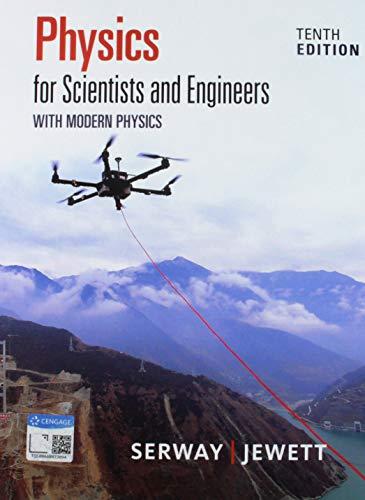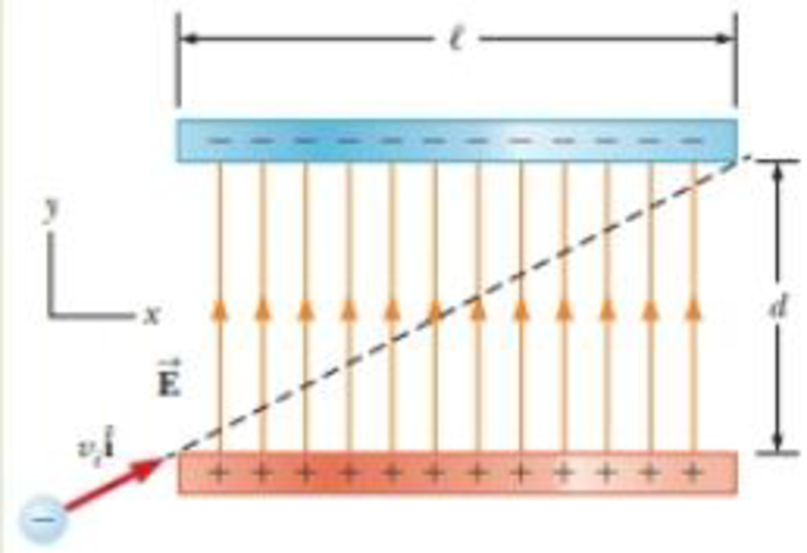
Concept explainers
You are working on a research project in which you must control the direction of travel of electrons using deflection plates. You have devised the apparatus shown in Figure P22.28. The plates are of length ℓ = 0.500 m and are separated by a distance d = 3.00 cm. Electrons are fired at vi = 5.00 × 106 m/s into a uniform electric field from the left edge of the lower, positive plate, aimed directly at the right edge of the upper, negative plate. Therefore, if there is no electric field between the plates, the electrons will follow the broken line in the figure. With an electric field existing between the plates, the electrons will follow a curved path, bending downward. You need to determine (a) the range of angles over which the electron can leave the apparatus and (b) the electric field required to give the maximum possible deviation angle.
Figure P22.28

Trending nowThis is a popular solution!

Chapter 22 Solutions
Bundle: Physics For Scientists And Engineers With Modern Physics, 10th + Webassign Printed Access Card For Serway/jewett's Physics For Scientists And Engineers, 10th, Multi-term
Additional Science Textbook Solutions
College Physics: A Strategic Approach (3rd Edition)
Genetics: From Genes to Genomes
Chemistry: Atoms First
Organic Chemistry
Fundamentals Of Thermodynamics
Campbell Essential Biology with Physiology (5th Edition)
- 220 V is supplied to 800 primary turns of an autotransformer. What will the outputvoltage be across 200 secondary turns? 2. A filament transformer has a turns ratio of 1:20. What current must be supplied to theprimary windings if 5 A is required by the filament? 3. The filament transformer in the previous question is supplied with 150 V to theprimary side. What is the secondary voltage? 4. 440 V is supplied to 1000 primary turns of an autotransformer. If the desired outputvoltage is 100 V how many secondary turns must be tapped?arrow_forward220 volts is supplied across 1200 winding of the primary coil of the autotransformer.If 1650 windings are tapped, what voltage will be supplied to the primary coil of thehigh-voltage transformer?2. A kVp meter reads 86 kVp and the turns ratio of the high-voltage step-up transformeris 1200. What is the true voltage across the meter?3. The supply voltage from the autotransformer to the filament transformer is 60 volts. If theturns ratio of the filament transformer is 1/12, what is the filament voltage?4. If the current in the primary side of the filament transformer in question 3 were 0.5 A,what would be the filament current?5. The supply to a high-voltage step-up transformer with a turns ratio of 550 is 190 volts.What is the voltage across the x-ray tube?arrow_forward220 V is supplied to 800 primary turns of an autotransformer. What will the outputvoltage be across 200 secondary turns? 2. A filament transformer has a turns ratio of 1:20. What current must be supplied to theprimary windings if 5 A is required by the filament? 3. The filament transformer in the previous question is supplied with 150 V to theprimary side. What is the secondary voltage? 4. 440 V is supplied to 1000 primary turns of an autotransformer. If the desired outputvoltage is 100 V how many secondary turns must be tapped?arrow_forward
- Assume ax(u) is constant, then show thatarrow_forwardOne strain of bacteria was found to have a membrane potential of -120 mVmV at a pHpH of 7.5. A bacterium can be modeled as a 1.5-μmμm-diameter sphere. How many positive ions are needed on the exterior surface to establish this membrane potential? (There are an equal number of negative ions on the interior surface.) Assume that the membrane properties are the same as those of mammalian cells.arrow_forwardQ: Draw the fabrication layers of a transistor with metal and semiconductor MS junction (Schottkyj unction).arrow_forward
 Physics for Scientists and EngineersPhysicsISBN:9781337553278Author:Raymond A. Serway, John W. JewettPublisher:Cengage Learning
Physics for Scientists and EngineersPhysicsISBN:9781337553278Author:Raymond A. Serway, John W. JewettPublisher:Cengage Learning Physics for Scientists and Engineers with Modern ...PhysicsISBN:9781337553292Author:Raymond A. Serway, John W. JewettPublisher:Cengage Learning
Physics for Scientists and Engineers with Modern ...PhysicsISBN:9781337553292Author:Raymond A. Serway, John W. JewettPublisher:Cengage Learning Physics for Scientists and Engineers: Foundations...PhysicsISBN:9781133939146Author:Katz, Debora M.Publisher:Cengage Learning
Physics for Scientists and Engineers: Foundations...PhysicsISBN:9781133939146Author:Katz, Debora M.Publisher:Cengage Learning Physics for Scientists and Engineers, Technology ...PhysicsISBN:9781305116399Author:Raymond A. Serway, John W. JewettPublisher:Cengage Learning
Physics for Scientists and Engineers, Technology ...PhysicsISBN:9781305116399Author:Raymond A. Serway, John W. JewettPublisher:Cengage Learning Principles of Physics: A Calculus-Based TextPhysicsISBN:9781133104261Author:Raymond A. Serway, John W. JewettPublisher:Cengage Learning
Principles of Physics: A Calculus-Based TextPhysicsISBN:9781133104261Author:Raymond A. Serway, John W. JewettPublisher:Cengage Learning College PhysicsPhysicsISBN:9781938168000Author:Paul Peter Urone, Roger HinrichsPublisher:OpenStax College
College PhysicsPhysicsISBN:9781938168000Author:Paul Peter Urone, Roger HinrichsPublisher:OpenStax College





